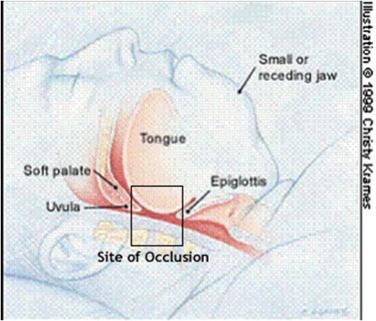Physical Address
304 North Cardinal St.
Dorchester Center, MA 02124
I would like to thank Saifur Rashid for editing this manuscript.
Obstructive sleep apnea (OSA) affects 2%–4% of the adult population and is most commonly seen in middle aged, overweight men. A study at the University of Wisconsin showed that 4% of men and 2% of women, aged 30–60, have undiagnosed sleep apnea ( ). A 2004 report from MedTech Insight indicates that the prevalence of OSA in the United States is 28.2 million patients. Of these, 12, 8.8, and 8.1 million have mild, moderate, and severe OSA, respectively ( ). The degree of severity is determined by the apnea-hypopnea index (AHI). The AHI is the number of apneic and hypopneic episodes per night, and can reach up to 60 for patients with severe OSA. Of the 16.4 million patients with either moderate (AHP > 15) or severe OSA (AHI > 50), 15.6 million patients remain untreated. These patients develop upper airway occlusions ( Fig. 109.1 ) related to the prolapse of the tongue and its surrounding structure in the pharynx. This prolapse has been attributed to diminished neuromuscular activity in the upper airway dilating muscles ( ) during an occlusion as indicated by electromyogram (EMG) recording from the main protruder of the tongue, the genioglossus muscle. During wakefulness, OSA patients have an augmented genioglossus activity compared to patients without obstructive sleep apnea. However, this neuromuscular compensation may be lost during sleep thereby generating a collapse of the upper airway ( ).

OSA is also associated with arterial oxygen desaturation and subsequent arousal from sleep ( ). Referred to as the snorer’s disease, it has been suggested that OSA involves a gradual degeneration of the upper airways (UAW) mucosal receptors in addition to a progressive deposition of lipid tissue in the UAW lumen ( ). This gradual loss in muscle tone and inherently narrow UAW anatomy, both of which facilitate larger negative intraluminal pressure swings during inspiration, are considered the main factors that predispose individuals to OSA.
There are other several predispositions to OSA such as obesity ( ), ethnicity ( ), pharyngeal wall thickness, enlargement of the tongue, and retroposition of the mandible and/or hyoid bone ( ). The frequent and repeated nocturnal episodes of occlusion produce microarousals and lead to excessive daytime sleepiness (EDS). Aside from the chronic fatigue associated with EDS and increased risk for automobile accidents, OSA patients exhibit a greater likelihood for developing more serious long-term pathologic sequelae including hypertension, right-sided heart failure, arrhythmias, and stroke ( ).
Initial treatment of OSA involves a series of lifestyle changes followed by nonsurgical treatment options. The most common nonsurgical treatment is Continuous-Positive-Airway-Pressure (CPAP). It has been shown to be effective in reducing the symptoms of OSA in patients who use it on a regular basis ( ); however, there is a high rate of noncompliance (∼40%) ( ) mostly due to patient discomfort.
Surgical procedures for the treatment of OSA include opening one or more of the sites of breathing obstruction, via adenoidectomy, tonsillectomy, nasal polyp removal, airway abnormality correction, uvulopalatopharyngoplasty (UPPP), or, in the most severe cases, tracheotomy or surgical jaw reconstruction, nasal airway surgery, palate implants, tongue reduction, genioglossus advancement, hyoid suspension, maxillomandibular procedures, bariatric surgery, or combinations of these procedures. Many of these procedures are very invasive and not always effective. The most common surgery for OSA patients (UPPP) is initially successful but the success rate drops to 46% after a 13-month period ( ).
However, the physiology and anatomy of the UAW muscles suggest that the UAW patency could be preserved during sleep through electrical stimulation of the tongue muscles ( ). Stimulation of the hypoglossal nerve has been shown to coactivate the tongue protrudor and retractor muscles resulting in airway clearance ( ). This conclusion is based on results obtained from both animal and human experiments.
Become a Clinical Tree membership for Full access and enjoy Unlimited articles
If you are a member. Log in here